
Larry Verstraete
Profile by Dave Jenkinson.
 The second oldest of six children, Larry Verstraete was born on April 18, 1948, in St. Boniface, MB, then a separate city but now part of Winnipeg. Like many young boys of his generation, Larry aspired to a career as a cowboy. “For a long time, I wanted to be Roy Rogers’s sidekick. All the active things were on my young ‘career’ list, including being a firefighter or a superhero. Superman was a real role model for me. At one point, I wanted to be a dentist, but eventually I became a teacher, something I did for more than three decades.”
The second oldest of six children, Larry Verstraete was born on April 18, 1948, in St. Boniface, MB, then a separate city but now part of Winnipeg. Like many young boys of his generation, Larry aspired to a career as a cowboy. “For a long time, I wanted to be Roy Rogers’s sidekick. All the active things were on my young ‘career’ list, including being a firefighter or a superhero. Superman was a real role model for me. At one point, I wanted to be a dentist, but eventually I became a teacher, something I did for more than three decades.”
“When I was in high school, I had some really topnotch science teachers, and that’s where my interest in science came from. My chemistry teacher, in particular, used to do interesting things in the class, like making tear gas and providing samples for us. I got turned on to science from him and also a physics teacher that I had. By the time I reached grade 12, chem and physics were my top marks.”
“I went into science at the University of Manitoba because I loved science. I really didn’t know what I was going to do with the degree, although, at one point, I saw myself as a researcher. Somewhere in second year, I had an interview with the Grain Commission who were looking for somebody to work in their labs in the summer time. As they were talking to me, I realized that I knew very, very little about science and certainly not the practical end of it. Then, when we went through the labs and I saw the people doing the same operation, like titrations, over and over, I realized that a lifetime of this was not exactly what I wanted to do. I never did get that job anyway which is probably a good thing.”
“I think that particular experience steered me away from more narrow scientific endeavours, and so by the time I got my B. Sc. degree, I really didn’t know what I wanted to do. Somehow, teaching seemed to be the right choice, and I went back for the one year certification program. Later, I finished the B. Ed. degree part-time over summers. In 1988-90, I went back to university full-time for my M. Ed.. During the first year, I was on a sabbatical, and I had a deferred leave for the second year. Over those two years, I took my course work, did the thesis and, because my schedule was freer, set up a model for family travel that we’ve followed ever since.”
“Our kids were pretty young then, with our son being in grade 3 and our daughter in kindergarten. We took them out of school in May and June. I thought it would be a great time to travel as a family. We ended up purchasing an RV, and one year we did a western tour of the United States and Canada, and the next year we did the eastern tour route. The plan was to sell the RV at the end of the second year because we couldn’t really afford it, but we liked that mode of travel so much that we kept it. Every summer after, we would go out as a family and spend four weeks wherever. We still have an RV, a newer one, and some day, my wife Jo and I are going to go on the road with it for two or three months at a time. Now we just do summer trips when she can get holidays.”
Perhaps as a precursor to the writing that would come in his adult years, somewhere about grade 4 or 5, Larry had a very brief flirtation with starting his own newspaper of The National Enquirer ilk. “I don’t know where the origins of the printing press story are or why I really wanted it. I think it may have stemmed from all the reading I had been doing from a young age, and somehow the printed page was what I was after. In an Eaton’s catalog, I came across this toy printing press, and it seemed like the right thing to ask for as a Christmas present, but, when Christmas came, it wasn’t there because I don’t think anybody really thought that I was that serious about wanting it. It was only when I asked for it again the following Christmas that I got it.”
“I don’t remember really using the printing press at all except for this one project that my friend Edward and I had in mind for the following summer. We were going to create a newspaper of some sort. The plan was that we were going to spy on our neighbours and gather all these little juicy stories in our neighbourhood. We would churn them out into written stories and then set them into type on the printing press and print out copies. Somewhere in these glorified plans we were going to make money from the whole thing by going back to the neighbours, the ones upon whom we had been spying, and selling them copies.”
“The spying part and all of that was, of course, great fun, and the writing portion, which we did by hand, was less fun. However, when it came time to use the printing press and mount all these little rubber letters that had to be inked, that’s where the project died. Within doing three lines of this, we realized it was an ‘impossible’ task, and we were already tired of doing it. I think that was my first taste of writing and publishing.”
Larry’s recognition of the power of words and the author’s need to take audience into account came about in a most unusual way - a game of “crotch” tag that took place when Larry was in grade 8. “It’s a very clear memory because it was rather traumatic. I was always one of these really ‘good’ kids, but in April of that year, a group of friends and I invented a game of tag that we played during recess. The little element of ‘risk’ in our game was that you had to ‘tag’ the person in a ‘private place’ and then run so that you wouldn’t be caught or tagged back. We were playing this game at recess, not realizing that the principal of our all boys’ school had been watching from his office on the second floor.”
“Because there was a religious element to the school, this sort of behaviour was definitely frowned on. By the time we came in from recess, the principal was already standing at the classroom door, and he called us all aside. He ranted and raved, calling us all kind of things. We all got the paddle, three whacks on the rear end, with me being one of the last ones to get it. We all thought that the paddling ended the matter. We were wrong.”
“I guess the principal thought that physical punishment wasn’t quite enough because he came back and had us all write letters home to ‘explain’ our actions to our parents. He sent us back into the classroom to do the writing, and so, while the rest of the class continued on with their lessons, we were all writing at our desks. I recall this writing as being a horrible experience. I wrote draft after draft, but I couldn’t seem to get the words right. However, by the end of the afternoon, I had a letter of some sort. We all brought our letters up to the principal who told us that he wasn’t really going to send them home, but he was going to keep them in the school’s safe. Should we ever repeat anything like this, the letter would go home.”
“It was only later that I realized why that whole experience was so difficult for me. It was because I was trying to write for two different audiences. One audience consisted of my parents where I was trying not to make myself sound too bad for them. Of course, the principal was the second audience, and he knew the correct details, and so I was trying to strike a balance between the two which was really difficult.”
“Out of that experience, I began to realize that you could make words do what you wanted them to do. You just needed to spend a lot of time with them. The other realization was that nobody sees the drafts. They just see the finished product. Those two learnings have stayed with me. I can write and put whatever I want on the page. It’s only the final product that people are going to read. No one cares how much time you put in or the fact that you got stalled for three days on one little paragraph. It doesn’t really matter how many efforts you make at what you’re writing. And, because nobody knows that, it gives you a certain freedom.”
“I think it was always in the back of my head that I would write something publishable some day, but I actually thought it would be fiction. I was going to be the ‘great’ Canadian novelist or something. It was 1985 or so while I was sitting in a barbershop and going through a magazine that I saw this little clip-out ad for a writing course via correspondence. It was reminiscent of a time when I was in grade 10 or 11 and I really, really wanted to be a cartoonist. I would doodle in class, and I had a little ‘studio’ set up in the corner of my bedroom. Back then, I saw a similar ad in a magazine asking, ‘Do you want to be a cartoonist?’ It was for a correspondence course, and I desperately wanted to do it. As I recall, we even had somebody from the agency come to visit to explain things to my parents. In the end, we just couldn’t afford it. With six kids, my parents didn’t have enough money to go around. My dad was a carpenter, and my mom didn’t work, and so that idea got kyboshed.”
“When I saw that ad while in the barbershop, it was like, ‘Oh, here is another opportunity. Why don’t you grab this one?’ And so I did, partly because I liked the writing idea, but partly because of that memory of the cartooning experience. I’d already been teaching for probably 15-18 years when I saw this ad. Our daughter was just a few years old, and that was one of the concerns: ‘How are you going to do this when you’ve got a son and a daughter now? How do you balance this whole thing out, doing the course and the assignments? You wanted to write, but you’re also going to be teaching full-time.’ I didn’t want to give up teaching by any means as I never really saw writing as my primary career. I saw it more as a side-interest at the time.”
“I applied for the course and received the little aptitude test which I did and mailed in. I got a reply saying, ‘You qualify.’ At that point, I thought, ‘Probably everybody does.” I remember having a long discussion with my wife because this course was fairly expensive. I had started a few other things before this, and Jo was probably thinking, ‘Oh, here we go again. Another one of “those” ideas,’ but we worked it out.”
“The course was a series of assignments that you received in the mail. You did one and mailed it back to an author at the other end who critiqued it and gave you support and encouragement. Then you moved on to the next assignment. The first three assignments were fiction, but suddenly the fourth was nonfiction. It asked you to pick a topic of interest to kids and write an article about it.”
“I chose lightning as my subject, figuring that was an easy one because I was a science teacher. I did the initial research, and, of course, the whole Benjamin Franklin story was buried in everything about lightning that I read. Then I realized there was another story behind the whole Benjamin Franklin ‘flying the kite’ story. Years before, Franklin had dabbled with Leyden Jars which were like primitive batteries able to hold a little bit of electrical charge. Franklin experimented and improved them by trying different components and combinations. He figured that he could actually get a good walloping charge by linking a bunch of them up.”
“According to the story, Franklin decided to show off his creation by inviting his neighbours over at Christmas time. His plan was to electrocute a turkey with the Leyden Jars. Instead of that happening, Franklin actually backed up into the table holding the Jars and gave himself the shock. At the moment he actually got shocked, Franklin heard a huge clap of noise and then saw a spark. Those two things together made him think of lightning, and then the kite experiment followed from that.”
“Once I had that story, I realized that kids were going to love it. I refocused the article so that, instead of really writing about lightning, I wrote about an accidental discovery. Doing that led me to think, ‘I’ve heard stories like this before in science.’ I started to do the research, picking up stories about breakthroughs that had an element of accident or mishap to them. While I was doing assignments for the course, I was also collecting this information and writing these stories. Towards the end of the course, I realized that I had 20-30 of these things and that it could become a book.”
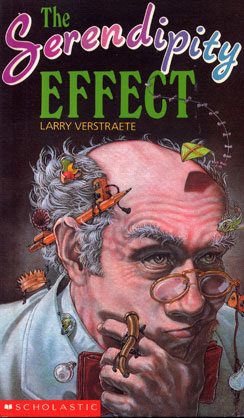
“I then explored ways of shopping my manuscript around. While the course offered a few suggestions, I really had to do my own research. I actually started off totally in the wrong way by sending the whole manuscript off to a publishing firm that I thought would publish this kind of work. After waiting months to get a reply, I got my package back with a little note that essentially said, ‘Thanks, but no thanks.’ Realizing then that sending the whole manuscript wasn’t really the way you were supposed to approach things, I wrote a query letter and sent it to three publishers, with one of them being Scholastic. After getting a favourable reply from Scholastic, I sent them a more developed proposal and a sample chapter.”
“I then put the idea behind me, but one day I received a phone call at school. The secretary called me down, saying, ‘It’s Scholastic on the line.’ My first thought was they were calling about a delinquent account with the students’ book club and that I had ordered books and not paid. The call turned out to be from one of Scholastic’s editors saying they were interested in the book and asking, ‘Did I still have it available?’ At that point, I’m sure I cleared the floor by about two or three feet as I replied, ‘Yes.’ And so that’s how The Serendipity Effect came to be. I recognize that I was really lucky because I just happened to hit the right publisher at the right time. I hear of people collecting rejections for years, and basically, other than my first experience where I sent out the whole manuscript, this was my next attempt.”
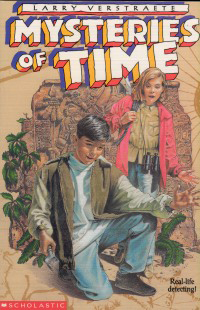
“I knew that I wanted to write more, but I didn’t know where that was going to go. However, now that I was into writing about science and had really enjoyed the whole experience, I thought that’s where I would head next. Because archeology was an interest, I wanted to work on something in that area, and so that’s where the next book, Mysteries of Time came from. During that period, I was also working on my thesis which involved much writing and research and so there was a lag between the first book and the second.
“One day a year or two later, I was home sick, not so sick that I really couldn’t have dragged myself in, but sick enough to know that I wouldn’t do a good job at school that day. As I was home recovering, I began thinking of what I was going to write next. I scratched out a plan that actually involved three books. It meant taking a look at science from three different perspectives, with one being about how we make discoveries, another being about how those discoveries are applied, and the third being about how we use those discoveries or applications in a practical everyday way.”
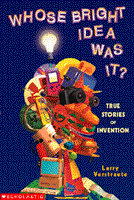
“In the end, I realized I actually had the first book already done (because that was The Serendipity Effect) and that what I really had in mind were two additional books. One was on inventions and how we use them. The third one was something that, in my head, I was calling “Science to the Rescue: We Use This in Science.” Whose Bright Idea Was It? became the second book while Extreme Science, a look at some of the more dangerous things that scientists and inventors do, actually became an offshoot of it. “Science to the Rescue” which I saw as a companion to Extreme Science, I didn’t write, but I still have it as a proposal that I’m fine-tuning. I think there’s still room for that one some day.”

“The Serendipity Effect became republished as Accidental Discoveries. It came out at the same time that I was working on Whose Bright Idea Was It? I think my editor at Scholastic saw crossover opportunities between the two books. We took out some of the content from The Serendipity Effect because it had found its way into Whose Bright Idea Was It? and then looked for some other material to refresh it.”
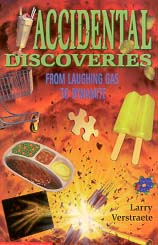
“After all these science books, I was ready for a different kind of writing. Looking at these earlier books, what I’d really been doing was ‘short story’ writing. I’d been taking stories from science and blending facts and trivia with them to make a book, but it was very much ‘story’ driven. I’d been looking for a new topic, and then two things happened. One was an earlier experience where we’d gone on one of our RV trips to Colorado and I got lost hiking on a mountain with the family. That event was the germination behind the next book because I realized that we were lucky. We’d done ‘stupid’ things and ‘smart’ things but mostly ‘stupid’ things, and we were lucky to walk out of that situation as easily as was we did.”
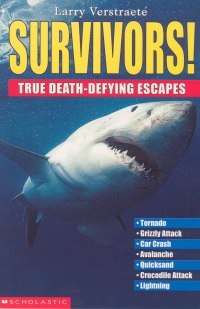
“The second was my picking up a newspaper article about a woman who had survived a hurricane some 20 or 30 years before. She’d been swept away and happened to grab hold of a tree and pull herself up, and that’s how she rescued herself. These two things together made me think about a whole book about survival. Survivors: True Death-Defying Escapes gave me opportunities to write in a different way, and I was able to use a more creative nonfiction or narrative nonfiction style. The contents were also more present day, and so that meant interviews, talking to people, looking for a range of stories and writing from a different kind of perspective than I had been using for the previous science books.”
“The origins of Lost Treasures: True Stories of Discovery are definitely from my childhood. I had explored the whole idea of archeology and finding treasure in Mysteries of Time, but it was really done from a scientific point of view. As a kid, I was always on the lookout for treasure. I collected coins and checked the dates on them. I’d have everybody empty their pockets, and I’d rifle through the change to see if there was something ‘old’ in there. Later, I would check the reference books in the library to see if the coins were actually of any value. I never did find anything. Recalling that experience, I figured a book about looking for treasures might be a natural kid kind of thing.”
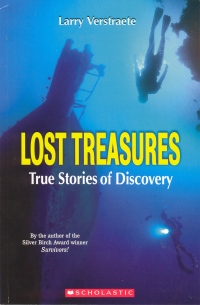
“A long time ago, I had developed a proposal for a book about stories of courage. I think I called it ‘Uncommon Courage.’ I pitched it to Scholastic who, at the time, was the only publisher that I was working with. I was writing on a part-time basis and one publisher and one book at a time were pretty much all I could handle. Scholastic said they already had books on courage, and so I put that one on the side. Still I felt there was something there of merit. I just wasn’t sure what to do with it right then.”
“After Lost Treasures, I dusted off ‘Uncommon Courage,’ looked at it again, and realized there was a different angle to the whole thing. The stories I had in mind were really about people who were forced into corners during times of crisis and had to act and make decisions at critical moments. Realizing it was stories about dilemmas more than stories about courage, although courage could be part of these stories, I reframed the proposal, included a few other examples, and passed it by Scholastic. With input from the editor, I fine-tuned the concept, and eventually it became At the Edge.”
“The book explores the decisions that the people make in various situations while the epilogue looks at some of the factors or motivations behind those decision. So, really the book is a presentation of stories without a lot of analysis, but each one involves a critical decision for good or for bad that somebody had to make. There are four chapters: At the Edge of Disaster, At the Edge of Terror, At the Edge of Injustice and At the Edge of the Impossible.”
“An example would be a situation that came up in the Asian tsunami in 2004. Jillian Searle, an Australian woman on holiday with her family in Thailand, was outside with her two young boys when the wave struck. She was left with the two kids but was not able to stay afloat while holding on to both, and so she had to decide which son to save. It was one of those crisis situations, a dilemma moment where you must ask, ‘What do you do?’ and ‘Is there a right thing to do and a wrong thing to do?’”
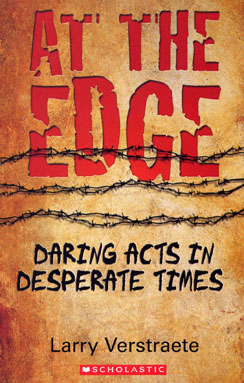
“In each of the four chapters, there are five or six stories about different situations, and so, in total, we have 22 major stories plus a number of sidebar stories throughout various chapters. The book concludes with a story of Terry Fox, a different kind of story because it’s not really a life or death situation in the usual sense, but it is still a decision-making story. It ends At the Edge on a positive note about what we might do as groups of people.”
Larry has another publisher as well now, and that came about because of CM. Over the years, CM has reviewed numerous books from Sleeping Bear Press, including a number of their provincial alphabet books, such as A is for Algonquin: An Ontario Alphabet and B is for Bluenose: A Nova Scotia Alphabet. When Sleeping Bear decided to undertake a Manitoba-based alphabet book, they approached me, as CM’s editor, to see if I had any suggestions for an author or illustrator. For the former role, I immediately thought of Larry as I knew his work and had previously invited him to speak to my YA lit classes at the Faculty of Education about writing nonfiction.
Sleeping Bear acted on my suggestion, and, in turn, Larry accepted the challenge. “I saw it as a different opportunity, a chance to work for a second publisher for one thing and to write something about my own home province. At the same time, I found the idea terrifying because I felt a great deal of responsibility to represent my entire province fairly and to do it in 26 letters while, at the same time, making sure that I was talking about its north, south, east, and west divisions, its history, people, attractions, wilderness, the whole thing. A lot had to be included in order to make the final product fair and representative of my province.”
The Sleeping Bear alphabet books are similar in format in that each letter of the alphabet is represented by both a poem and a prose section. “The poetry was quite a new undertaking, and while I’d previously written poetry here and there for myself, that part of the book took a little time. I know people will look at the poetry and think, ‘Oh, that’s easy,’ but actually it wasn’t that easy for me. It was definitely the biggest challenge. One line has to contain the letter of the alphabet and that was fairly restricting. When you have something like Upper and Lower Fort Garry as your ‘Uu,’ that’s a mouthful for even one line. I found that if I started an entry with the poetry, I often worked myself into a corner and became frustrated. Then I realized that if I wrote the expository text first, I, at least, had something to say in the poem. Working that way, writing the poem after the expository text, made it a little easier.”
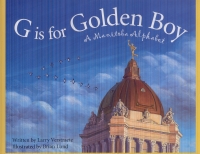
“The challenging letters in G is for Golden Boy were all the ‘familiar’ ones, the X, Q and Z. What I did was create a list, a master chart of A to Z options for each of the letters in the alphabet, using my memory of places and people. I added to the list as I researched the province and consulted with Travel Manitoba. Additionally, Sleeping Bear Press did have some parameters to the project. They wanted something about provincial emblems, famous people in Manitoba, the province’s geography, culture, and so on. I started looking at my list to make sure that I had hit all of those areas.”
“The other step involved making sure that I was representing each area of the province. I realized that, if I was going to start using my letters to name cities or towns, then the expectation, at least in my own mind, would be that I had to include them all. If I was going to say ‘Bb’ is for Brandon, well why wouldn’t I say ‘Nn’ is for Neepawa? Consequently, at the very beginning, I made a ‘ruling’ to myself that I wouldn’t use any of the letters for places like towns or villages, even Winnipeg, but I would see if I could incorporate them in other ways. In the end, that worked out well.”
“Similarly, I was faced with decisions around questions like, ‘How do you represent all the festivals and things that are happening across Manitoba?’ At one point, I was going to do ‘Ff is for Festival du Voyageur,’ but again it was the same kind of thing as the cities and towns. If you name that one, how can you not name all the others that are just as important? Consequently, that became the ‘Hh is for heritage festivals’ where I could group a few of these events under the broader heading. It was the same for ‘Oo is for outdoor art’ because how could I mention the catfish at Selkirk but not the goose at Lundar?”
The book’s artist, Brian Lund, was actually identified by Larry. “Sleeping Bear was searching for someone to do the art, and I thought of Brian. He’s a surveyor, and we’ve been friends for 30 years or more. He’s always done art on the side, but since he’s retired, he’s done more of it. When I’d go to his place, I’d see framed pieces of his around the house, and so I knew Brian did great work. At one point, I asked Brian if he’d be interested in doing this project. After he replied positively, I sent an email to Sleeping Bear saying, ‘I have a friend who does really great work. Would you be interested?’ They replied, ‘Have him send some of his stuff.’”
“Brian took it from there and sent them material. He didn’t hear anything for about six months or so, and then suddenly he had the job. He tackled the project the way he always does by doing a lot of research and taking many photographs. He tries to make sure that everything is true and representative of the actual situation. Brian did an excellent job of interpreting what was in my words and putting it on the page. He used oils for his illustrations.”
Larry’s first experience with Sleeping Bear has led to a second book with them, one that presently has the working title “Science Discovery Alphabet Book.” “Eventually, it will be given a title similar to other Sleeping Bear books, something like ‘C is for Compare: A Science Discovery Alphabet.’ I had always wanted to do something more on scientific discoveries. When the alphabet book format came up, I thought it would be a good way to organize the information. I proposed that each letter of the alphabet would stand for an activity or process that scientists do or use, and the text that follows would be about a discovery that was made through that activity or process.”
“An example would be ‘T is for Tag.’ The story that goes with it concerns a Canadian scientist who is trying to track down the winter home of the monarch butterfly. For years, it wasn’t really known where the eastern monarch butterflies went during the wintertime. Professor Frederick Urquhart developed little tiny tags that he could put on the wings of the butterflies. He developed a tracking system so that when people found them further south, they would let him know where the butterflies were found. In 1976, after about 40 years of research, Urquhart actually found the monarchs’ winter home on a mountain in Mexico where literally millions of butterflies stay the winter.”
“Right now, I have at least three different projects on the move at different places that may, or may not, turn out to be published books in the end. There’s the science discovery book with Sleeping Bear Press, and I also have a proposal in to Scholastic right now. I also have another proposal that I’m waiting to send out to different publishers. I’d like to connect with one more publishing firm. With Scholastic, Sleeping Bear and one more, I think there would be potentially enough work (maybe too much) to keep me happy for some time.”
“I also have a collection of proposals that didn’t go anywhere, and I guess I have the option to send them to other publishers. I might be ready to do that now, but before I retired, I didn’t want to go through the whole process of finding a new publisher. Back then, I could do a simplified proposal for Scholastic and get some feedback on it, and it would either fly or not. If it didn’t, it was easier to come up with a new idea for Scholastic than it was to shop an old one around to new publishers and have to do all the work associated with that. You’re looking at a 40 or more page development if you really want to pass something by a publisher who is not familiar with your work, and, because I was a known quantity with Scholastic, I didn’t really have to go that complicated route with them.”
As to his process for writing. Larry says, “I get up every morning early and go to my favourite coffee place. Now that I’m retired, early’s actually a little later, but I’m at the coffee shop before 7 a.m.. When I was teaching, it would sometimes be as early as 5:30 a.m. or whenever the coffee shop was open. I don’t know if I really have a well-defined process, but I know that being at one spot and not being responsible to anybody else is a great kickoff for me. I look forward to mornings. To me, it’s not drudgery. It’s just part of my routine. Unless I have a deadline, I’m not set to doing a specified number of pages or anything like that.”
“Although I bring my laptop. I often start things by hand. I find that’s most liberating. When I was working on G is for Golden Boy, I found the poetry, itself, worked best if I just had a blank page. Forget the lines because even that seems ‘structured.’ If I just have blank paper (and I write big for some reason) that just seems to be all the more freeing. I’ll often start with a mind web. I throw down all the words I can think about, and sometimes that triggers a lead sentence or clarifies the approach I might take to tell a story. I find the very, very beginning, like the first paragraph, to be the hardest part to write.”
“I’m not one of those people that can do everything in draft and then come back and tune it up. I seem to have to get a really good start at it to know where I’m going. I’ll revise that opening and spend more time on it than I probably should. Until I catch my wind, so to speak, I really don’t feel that I can move on. I can’t work the whole story in draft and then come back to throw in additional details. Maybe it’s the logical scientific mind that wants order; I’m not sure.”
“I like doing the research, and it’s definitely a lot easier now with the Internet. We went through stages with the web when there wasn’t much there and where it was awkward and unreliable to use, but the search engines are so great now. You can just type in a couple of key words, and things magically seem to come up and often with lots of choices too. The Internet has opened up a whole world of research that wasn’t available before. Communication has also changed. To a great extent, you can do interviews via email and much of the discussion with editors is done that way, too.”
“Scholastic has sold the foreign rights to some of my books, and I’ve actually received quite a few foreign edition copies, including some in Mandarin and Ukrainian. I’m usually sent 10 copies of each one. The covers are different than they were originally, and, because they are in different languages, sometimes the only thing I recognize is my name. Once, when I received one of the foreign copies, I spent a fair bit of time going through it. Because even the illustrations were different, I kept wondering, ‘What book is this?’ It was one of the science books, but I didn’t know which one for a while.”
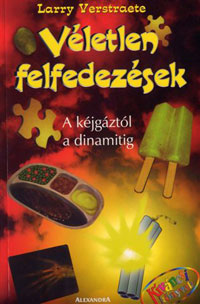
Mysteries of Time - Hungarian
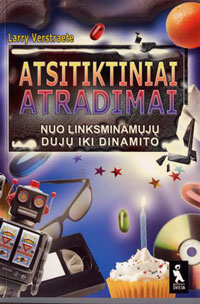
Mysteries of Time - Latvian
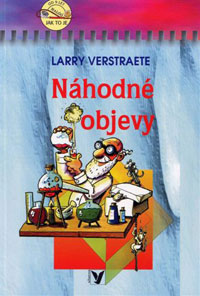
Mysteries of Time - Czech
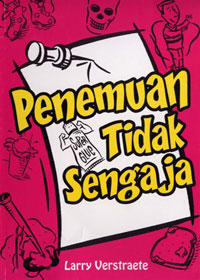
Mysteries of Time - Malay
Considering the place of nonfiction in children’s literature, Larry says, “When we say, ‘literature,’ we normally think fiction. We don’t usually think nonfiction is literature, but I believe it is, especially when you get to more narrative nonfiction styles of writing. To many people, nonfiction is one thing – dry facts. But those facts can be presented in many different ways and that leads to a great variety of approaches and creative opportunities. For someone writing for young people, the trick is to put in the facts in such a way that kids are going to want to keep reading.”
“Adults also need to realize that nonfiction may be the door into reading for some kids, boys in particular. Some can’t slog their way through a novel and won’t accept a novel with a female protagonist, but they will chart their way through material that they find fascinating on a subject that’s interesting to them. Even if they hit the most technical terms, they will still persist. Some like reading in short bursts, and they like being able to begin a book at any particular point without having to approach it in a more linear way. What I write is short material, often story-driven. For some reason, that’s often how boys prefer their reading, too. Give them something short, fast, dramatic or an odd-ball story perhaps, allow them to dip into the book at any entry point, and the facts come out of that as a secondary feature.”
One of the writing challenges that Larry faces is that of how much “story” can he create. “It’s really a very difficult balance to strike because you do have the facts to work with and you want to be ‘honest’ with them, but, on the other hand, if you’re exploring things like the narrative nonfiction style, you are going to borrow techniques from fiction. You do want to make it a story that grips the reader, but you also want to do it in an honest way. Consequently, you can’t make an event or happening overly dramatic or melodramatic when it really wasn’t. Sometimes, when a book is out, I’ll reread it and think to myself, ‘That wasn’t quite right,’ and I get a sense that maybe I straddled that line a little bit differently or even wandered over it a few times.”
“In some ways, I’m amazed that it’s been 20 years since I had my first book published. I also feel as if I’m just getting the wind in my sails as a writer. Now that I’m freer with my schedule to write, I realize that I don’t need to just stick to one book/one project at a time. I have a lot of ideas that I’d like to explore, but the trick is trying to get at them. I’ve found that, if I structure my day differently than I once did, I can be much more productive.”
“For whatever reasons, probably from my reading as a kid, I did have ambitions to be on the fiction end of things. Accepting the idea that writing nonfiction is perfectly fine was a hurdle that I had to cross over. I’m quite happy that I did as I find what I’m doing quite intriguing.”
Books by Larry Verstraete.
This article is based on an interview conducted in Winnipeg, March 31, 2009.
Visit Larry Verstraete’s website at www.larryverstraete.com
